Mimar Sinan, 80 years old, he and a “master piece” said the monumental structure of the masterpieces of Ottoman–Turkish art and architectural history. Ownership of the building foundation Sultan Selim. Edirne-Central New neighborhood. Mosque in Edirne, which is the symbol of the Ottoman Empire, the city’s center, formerly called Sarıbayır and Poplar Square location. Bayezid known to have built a palace here before. In 1569-1575 Sultan Selim II ‘was built upon the order.
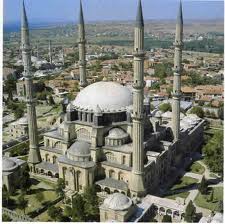
Selimiye Mosque
Structure with four minarets visible from far away, it was established, the choice of location, Mimar Sinan is a city planning expert shows that at the same time. 1620 m2 of the inner part of the mosque made of cut stone, totally covers an area of 2475 m2. Architecture on the widest place on the building known as the Selimiye Mosque, which is height of 43.28 m, 31.30 m diameter dome attract attention. Which is greater than the Hagia Sophia dome, 6 m wide, connected by arches sits on eight big positions. The corners of four, a half-dome over the central dome of the mihrab support. It has a unique structure in Turkey.
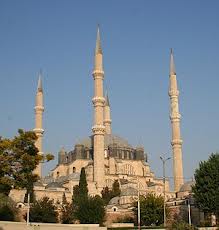
Selimiye Mosque
Structure, the drum of the dome 32 small window, the window is oriented to a large number of faces in a row 6 in the array. Mimar Sinan mosque plan created by the most successful example of 8-resistant. There are 18 in front of the dome and portico, surrounded by 16 columns. In the middle, there are marble and an elegant fountain. Last place of the community, 5 thick round 6 columns on the dome. Marble inlaid fluted domes on the entrance door, while others are flat. The mosque, 3.80 m wide, 70.89 m high, has four elegant minarets with three balconies. Check-in cheers and the only way that the other two had to climb three cheers separate ways.
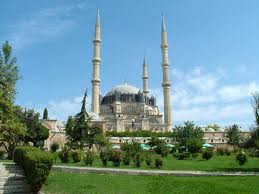
Selimiye Mosque
Mosques, besides the Turkish architectural features, stone, marble, tile, wood, mother of pearl decorative features, as well as extremely important. Marble altar and the pulpit of the masterpieces of craftsmanship. Muezzin gallery is located in the middle sitting on 12 marble columns. On the right is the library. There are sovereign gallery to the left of the altar. All the vitality of the ceiling of the lower part of this period show that the original pencil work. Domes and arches adorned the original pencil work, repairs, cleaning.
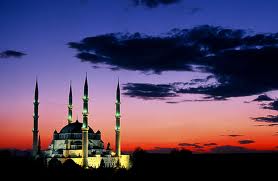
Selimiye Mosque
Structure of the tile decorations, Ottoman, and has a special place in the art world. The best examples of tile making XVI century, these tiles, made at Iznik is under-glaze technique. The mihrab wall, pulpit pavilion wall, sovereign gallery walls, women, gallery, Qibla direction window pediments decorated with tiles. Take the mihrab wall of the large tile panels, blue flower and leaf decorations, window wells white on dark blue, thuluth duration elhem written cartridges, is located on top of a broad border of the verse. Belvedere Pulpit tile panels, dark blue in the middle of the red, white spring flowers under the tree leaves, decorated with hyacinths and tulips.
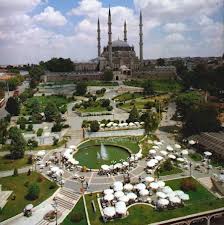
Selimiye Mosque
Draws attention to the richness and diversity sovereign gallery. Thuluth white on dark blue marble altar with a pointed arch pediment, verse text stand out. In this section, red, blue, green peonies, spring, trees, white on blue badge and the surrounding large floral panels, lozenge leaves, cloves and spring branches of the best examples of XVI century tiles.
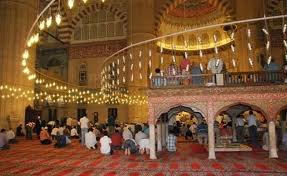
Selimiye Mosque
Sovereign gallery of tiles, bringing a palace here, which might be diagnosed later formed two apple tree apple decoration on a separate panel has a value of the original Ottoman tiles. In this section, pointed arch window pediments, dark blue, white on navy blue thuluth still on the hill between the two windows with the verses and white square Kufic dashboard attract attention. These tiles covering the walls of the half sovereign gallery, altar tiles more qualified. However, editing, and more straight forward in terms of monumentality.
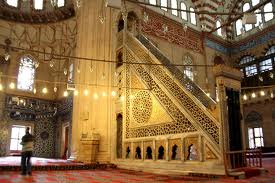
Selimiye Mosque
Selimiye Mosque is surrounded by stone walls and a large outdoor courtyard, Darul-lesbian, Darul-Darul-Kur and Hadith are structures. A portion of these structures and the madrasa, Edirne is the various sections of the Museum. Terrace of the mosque under the bazaar (market), the outlet to the time of Murat III was built as a foundation. Aga, who was the architect of David.
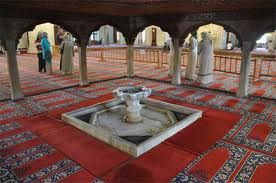
Selimiye Mosque
Edirne market is provided. Of construction documents, Enez some poles, a colored quarry products from Fere also writes brought marble from Marmara Island and Kavala. Evliya Çelebi, made of white marble courtyard, a place for the so-called Athens and Temasalik speak of the six columns. However, the Sanjak of Evliya Çelebi, Cyprus and Hüdavendigar Aydıncık Town requires Brought to spend as much as the other columns indicates a Egyptian Treasures. Some of the sources are met Selimiye Mosque is said that revenue from the Ottoman country of Cyprus, the cost of construction.
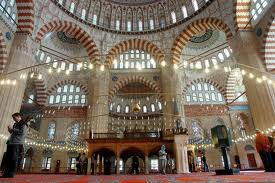
Selimiye Mosque
Suleiman’s son Selim hs made Selimiye, 22 June 1567, Istanbul, Edirne and the Austrians have remained here until the peace agreement. There are those who say the decision to build the mosque was given in those days. According to another narration by the Turks, “The Great Wall of Islam” Lara perceived Edirne, a dream that played a role in the selection of the sultan. Accordingly, the Prophet Muhammad, and the current location of Edirne Sultan pointed out that in this dream.
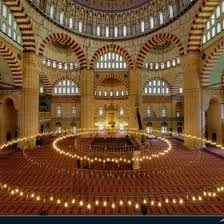
Selimiye Mosque
On the other hand, the interest of the city Selim II began in his youth, leaving him the throne of Suleiman the Magnificent Persian expedition left for the protection and the sultan in Edirne, Edirne is connected to a special fondness recalling, Edirne Preference claim that are affected by this situation. Explaining the reason for not living in a land that time the appropriate evaluations are seen in Istanbul. Selimiye construction started in 1568, decided to open on November 27, 1574, was opened for worship in 1575.
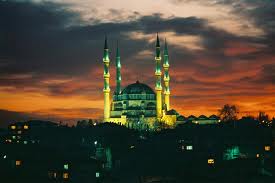
Selimiye Mosque
Selimiye Courtyard
Equivalent to each other consists of two rectangular area around the courtyard. The most impressive aspect of the west door opens into the courtyard. The entered through the door and the dish-shaped roof of white marble fountain faced with. This is the classical period of Ottoman architecture sixteen fountain is one of the most beautiful designs. Ie fountain in the courtyard dome 18 has 16 columns. Translates to an outdoor courtyard on three sides of Selimiye mosque. Selimiye mosque, surrounded by stone walls and outer courtyard of the Dar-ul-lesbian, Dar-ul-Dar-ul-Hadith Kur-a and has Structures. Garden gate number eight. Mimar Sinan Street, right turns on them, at first, the regiment’s Gate; qibla side of the little door; Beggar’s Gate, facing east in the middle one, called Mint Gate. There are four gates in the west of the mosque with a great gate. Selimiye garden, three Memorial Tree (London and East Plane Tree) are available.
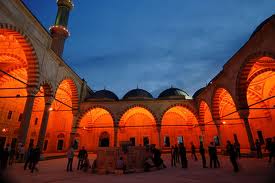
Selimiye Courtyard
The Dome of Selimiye
“In fact, for large space structures, domes, gradually, and became a head element, as well as the sky, God, have become the symbol of political power.” Pre-industrial architecture of the dome of Selimiye, in this sense, and the last point of the development of a single-domed structure conveys location as a “culmination point” is considered. Height of 31.22 m and 43.28 m in diameter weight is 2000 tons and eight columns (pillars) rests on. Ottoman Architecture dome of Selimiye, as well as the largest stage in the tradition of the domed structure. Dome stenciled decorations were restored between the years 1978-1985.
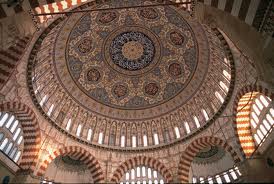
The Dome of Selimiye
Inverted Tulip Motif
The most curious motif. Muezzins Mahfeli’s towards the northeast, around the corner marble leg has a small inverted tulip motif. Widespread rumor that this tulip, tulips grow here and the person who owns the land in the mosque, issued for the construction of the mosque plot symbolizes the difficulties and the opposite stance.
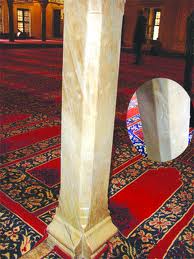
Inverted Tulip
According to some, working in the construction of the mosque, which is the product of a master blind to this tulip among the people, there are also other beliefs. For example, the words of Allah and the tulip flower with the same letters mystical presence neded to give you a sense of the sacred counted. In addition, the former written in capital letters, the word tulip, which is a sign of the Holy attainment of the Ottomans the crescent-only.
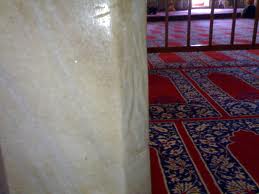
Inverted Tulip
Another approach to the sick and dying in those days, grandson of Mimar Sinan relates to Fatima. Accordingly, the node is already thick with broken tulip motif Sinan’s granddaughter is interested enough in the days when he was depressed and was put out by a journeyman.
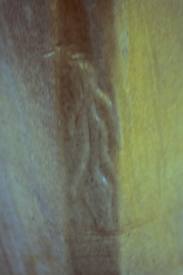
Inverted Tulip
Inverted tulip motif found in Selimiye, visitors, today is one of the most curious and different elements of the mosque continues to be myths. Tiles 101 separate tulip motifs were used on the reverse of Selimiye included. Selimiye Mosque, surface-mounted and wood painting pen tulip motifs used in different jobs. Muezzins’s part, including inverted tulip, Selimiye Tiles of different height, color and shape were determined using 101 different kinds tulip motif.